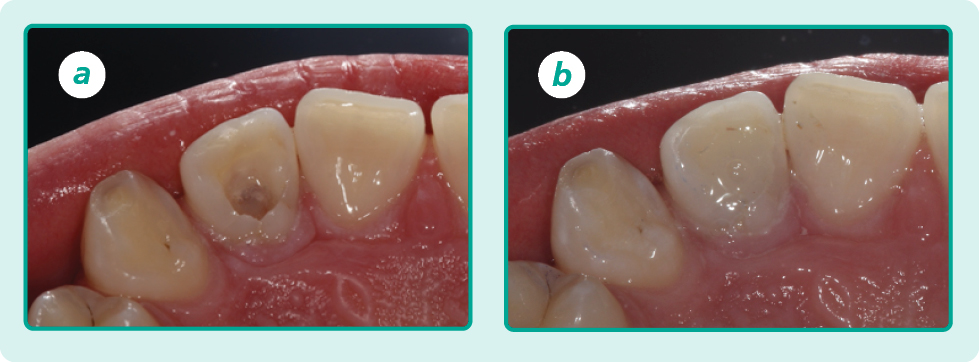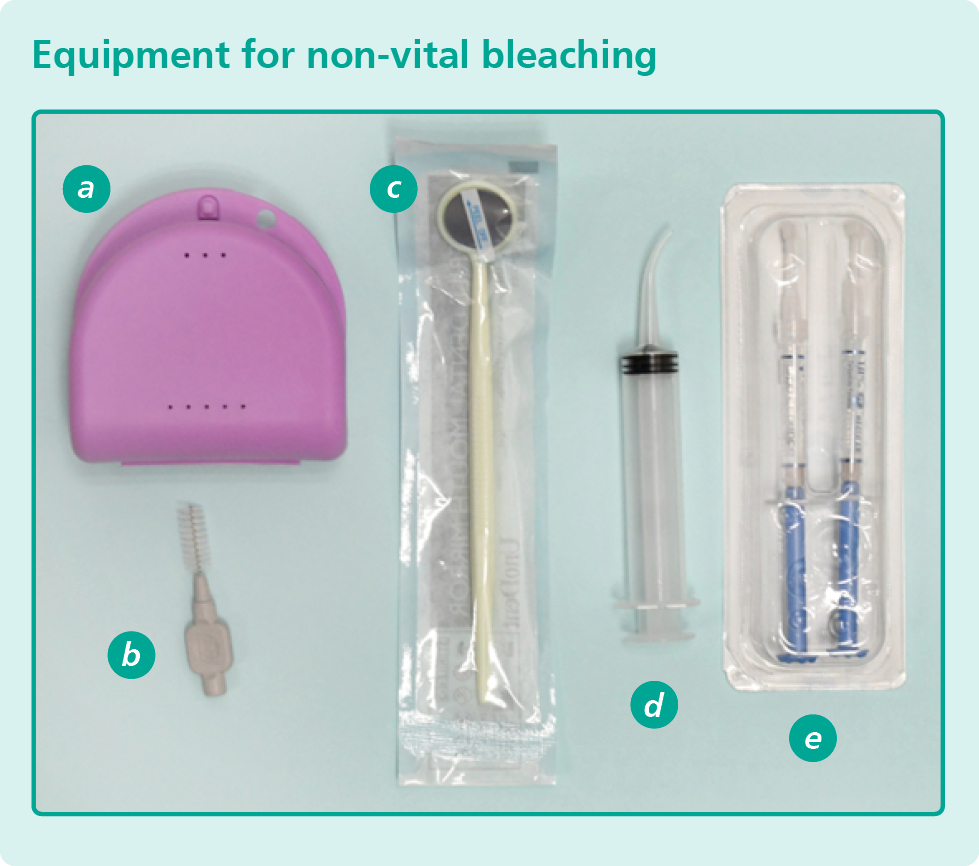On this page
- What is tooth whitening?
- Why would I want my teeth whitened?
- What does tooth whitening involve?
- What types of tooth whitening are there?
- What results can I expect from tooth whitening?
- What are the alternatives to tooth whitening?
- What will happen during vital bleaching?
- What will happen during non-vital bleaching?
- Other information that we think you should know
- Who do I contact with further questions?
What is tooth whitening?
Tooth whitening (or tooth bleaching) can be used to lighten the colour of teeth without removing any of the tooth surface. It can be used to lighten a single tooth or multiple teeth.
Why would I want my teeth whitened?
There are a number of reasons why you might consider tooth whitening. For example:
- Teeth can become darker after an injury or following a root canal treatment.
- Teeth can be discoloured by taking certain medications.
- The tooth may not form properly resulting in darker patches.

What does tooth whitening involve?
Tooth whitening should always be carried out by a trained dental professional. A bleaching gel is usually applied to the tooth or teeth using a specially made bleaching tray (pictured below).

The bleaching gel contains carbamide peroxide which breaks down into hydrogen peroxide and lightens the teeth. The tray can be worn during the day and/or at night and the gel can be replenished at regular intervals. There are a number of different types of tooth whitening. The two main types carried out at the Leeds Dental Institute are described below.
What types of tooth whitening are there?
Vital bleaching:
This is carried out on teeth with healthy nerves. Bleaching gel is applied to the bleaching tray and fitted over the teeth.
Non-vital bleaching:
This is carried out on teeth that have had root canal treatment, i.e. “dead teeth”. The filling is removed from the back of the tooth allowing the gel to be applied to both the outside and inside surfaces of the tooth. The hole in the back of the tooth can either be sealed or left open during treatment. A bleaching tray can be fitted over the tooth which allows the bleaching gel to be applied to the outside surface of the tooth.
What results can I expect from tooth whitening?
What are the benefits?
Tooth whitening can help lighten the shade of the tooth and is safe when carried out by a trained dental professional. It does not require the removal of any tooth structure unlike some other options that may be available.
What are the risks of this treatment?
- The effects of treatment will vary from person to person. Tooth whitening can be effective at lightening teeth but may not make a complete colour change. Sometimes additional treatment will be needed to achieve the desired result.
- Some teeth can become darker over time and may need repeated tooth whitening in the future.
- Tooth whitening will not alter the colour of fillings or veneers that have been previously placed on the teeth. Previous fillings may require replacement after tooth whitening, if they are no longer a good colour match.
- Some patients find that their teeth are more sensitive to cold food and drink for a short time during or after tooth whitening. This often improves a short time after completion.
- Some patients find that their gums become irritated by the bleaching gel. This risk can be reduced by using the correct amount of gel and wiping away any excess.
- Root resorption is a very rare complication where the body “eats away” the root of the tooth. This may lead to a need for surgical intervention or extraction of the tooth.
What are the alternatives to tooth whitening?
- No treatment – Some people may prefer to accept the colour of the tooth/teeth.
- Microabrasion – This involves applying an acid to a tooth and polishing away a thin layer of the tooth surface. This can be particularly effective to improve the appearance of brown patches on the teeth.
- Composite veneer – This involves covering your tooth/teeth with a layer of white filling material to mask the underlying colour. This will require maintenance with a dentist to polish, repair or replace the filling material as required.
- Porcelain veneer/crown – This involves removing some of surface of the tooth/teeth to make space for a layer of porcelain material. The veneer/crown is made in the dental laboratory and usually fitted 2-3 weeks later. This will require maintenance and replacement approximately every 10 years.
What will happen during vital bleaching?
Vital bleaching is carried out on teeth that are alive. It can be used to treat one or more teeth at a time.
Appointment one: Photographs will be taken of the teeth and records will be made of the tooth colour. Impressions will be taken of the teeth and sent to the dental laboratory for a specially made bleaching tray to be made.
Appointment two: The fit of the bleaching tray will be checked and you will be shown how to apply the bleaching gel. The bleaching gel and tray should be worn at night or as directed by the dentist until your review appointment approximately two weeks later.
Appointment three: An appointment will be made to review the tooth whitening. If further tooth whitening is required, your dentist will give you instructions and arrange another review appointment. Photographs will be taken to show the result and to monitor the tooth colour.
Instructions for use overnight:
- Before bleaching, clean your teeth thoroughly.
- Apply a small amount of gel into each space on the tray as instructed by your dentist and seat this over the teeth. Remove any excess with a soft, dry toothbrush.
- Wear the tray overnight.
- When you wake up, remove, rinse and brush the tray. Store the tray in the case provided. Rinse your mouth thoroughly with cold water and brush your teeth as normal.
- Try to avoid highly coloured food and drink that may stain the teeth during the bleaching process such as curry, red wine and tomato-based foods.
- Store the bleaching gel in the fridge when not in use. Remember to keep this out of the reach of children.
- Once you notice that the teeth are the desired colour or fail to lighten further… STOP bleaching.
- It is normal to experience some tooth sensitivity and for the gum to be whiter than normal. Both of these normally disappear a few days after stopping tooth whitening.
- If the teeth become very sensitive, change to using the bleaching gel on alternate nights. On a non-bleaching night, if advised to do so, apply sensitive toothpaste to the tray and leave in overnight. Use a sensitive toothpaste for toothbrushing and avoid very cold food and drink for the duration of bleaching.
What will happen during non-vital bleaching?
Non-vital bleaching is carried out on teeth that have had root canal treatment. In most cases, a single tooth will be treated, but occasionally more than one tooth is dark and needs treatment.
Appointment one:
Photographs will be taken of the teeth and records will be made of the tooth colour. Dental x-rays may be needed to check on the root canal filling prior to bleaching.
Impressions will be taken of the teeth and sent to the dental laboratory for a specially made bleaching tray to be made.
Appointment two:
The filling will be removed from the back of the dark tooth. The fit of the bleaching tray will be checked and you will be shown how to apply the bleaching gel.
The bleaching gel will be applied to both the inside surface of the tooth and the bleaching tray. You will be shown how to clean inside the tooth with a small brush.
The bleaching gel and tray can be worn day and/or night until your review appointment approximately 2-3 days later.

Appointment three:
An appointment will be made to review the tooth whitening. If further tooth whitening is required, your dentist will give you further instructions and arrange a review appointment.
After completion of bleaching, a temporary filling may be placed in the back of the tooth whilst the colour becomes stable. Photographs will be taken to show the result and to monitor the tooth colour.
Instructions for use:
- Before bleaching, clean your teeth thoroughly and clear any food remnants or old gel from the back of the tooth with a small brush. Use the syringe provided to rinse the back of the tooth with water.
- Apply a small amount of gel inside the tooth being treated and into the corresponding part of the tray as instructed by your dentist. Seat the tray over the teeth and remove any excess with a soft, dry toothbrush.
- Wear the tray throughout the day and repeat steps 1 and 2 every 4 hours.
- Remove the tray before eating and drinking. Try to avoid highly coloured food and drink that may stain the teeth during the bleaching process such as curry, red wine and tomato-based foods. Remember to clean the hole in the tooth after eating.
- After brushing your teeth at night and cleaning the hole in the back of the tooth, apply fresh bleaching gel and insert the tray before going to bed. Wear the tray overnight whilst sleeping.
- When you wake up, rinse and brush the tray and clean your teeth as normal.
- Store the bleaching gel in the fridge when not in use. Remember to keep this out of the reach of children.
- Once you notice that the tooth is slightly lighter than the teeth on either side… STOP bleaching, but continue to keep the tooth very clean until you attend for your review appointment.

Other information that we think you should know
What is the first aid advice?
The bleaching gel is irritating to eyes and skin.
- If it comes in contact with skin – wash thoroughly with soap and water. Seek medical attention if irritation continues.
- If it comes in contact with eyes – flush with water and seek immediate medical attention.
How should the bleaching gel be stored?
Bleaching gel should be refrigerated at home and kept out of the reach of children. Any unused bleach should be brought back to Leeds Dental Institute for safe disposal.
Who do I contact with further questions?
If you have any further questions, please contact the Restorative Department at Leeds Dental Institute on: 0113 343 1729.